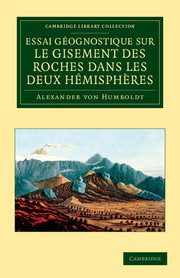
- Cited by 1
-
Cited byCrossref Citations
This Book has been cited by the following publications. This list is generated based on data provided by Crossref.
Debarbieux, Bernard 2012. Figures et Unité de l’idée de montagne chez Alexandre von Humboldt. Cybergeo,
- Publisher:
- Cambridge University Press
- Online publication date:
- June 2013
- Print publication year:
- 2012
- First published in:
- 1826
- Online ISBN:
- 9781139226868




